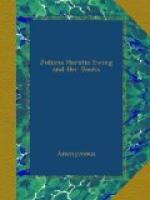Next to roses I think the flowers that Julie had most of were primulas of various kinds, owing to the interest that was aroused in them by the incident in “Mary’s Meadow” of Christopher finding a Hose-in-hose cowslip growing wild in the said “meadow.” My sister was specially proud of a Hose-in-hose cowslip which was sent to her by a little boy in Ireland, who had determined one day with his brothers and sisters, that they would set out and found an “Earthly Paradise” of their own, and he began by actually finding a Hose-in-hose, which he named it after “Christopher,” and sent a bit of the root to Mrs. Ewing.
The last literary work that she did was again on the subject of flowers. She began a series of “Letters from a Little Garden” in the number of Aunt Judy for November 1884, and these were continued until February 1885. The Letter for March was left unfinished, though it seemed, when boxes of flowers arrived day by day during Julie’s illness from distant friends, as if they must almost have intuitively known the purport of the opening injunction in her unpublished epistle, enjoining liberality in the practice of cutting flowers for decorative purposes! Her room for three months was kept so continuously bright by the presence of these creations of GOD which she loved so well:—
“DEAR LITTLE FRIEND,
“A garden of hardy flowers is pre-eminently a garden for cut flowers. You must carefully count this among its merits, because if a constant and undimmed blaze outside were the one virtue of a flower-garden, upholders of the bedding-out system would now and then have the advantage of us. For my own part I am prepared to say that I want my flowers quite as much for the house as the garden, and so I suspect do most women.” The gardener’s point of view is not quite the same.
“Speaking of women, and recalling Mr. Charles Warner’s quaint idea of all his ‘Polly’ was good for on the scene of his conflicts with Nature, the ‘striped bug’ and the weed ’Pusley,’—namely, to sit on an inverted flower-pot and ‘consult’ him whilst he was hoeing,—it is interesting to notice that some generations ago the garden was very emphatically included within woman’s ‘proper sphere,’ which was not, in those days, a wide one.”
The Letters were the last things that my sister wrote; but some brief papers which she contributed to The Child’s Pictorial Magazine were not published until after her death. In the May number “Tiny’s Tricks and Toby’s Tricks” came out, and in the numbers for June, July, and August 1885, there were three “Hoots” from “The Owl in the Ivy Bush; or the Children’s Bird of Wisdom.” They are in the form of quaint letters of advice, and my sister adopted the Spectator’s method of writing as an eye-witness in the first person, so far as was possible in addressing a very youthful class of readers. She had a strong admiration for many of both Steele and Addison’s papers.




